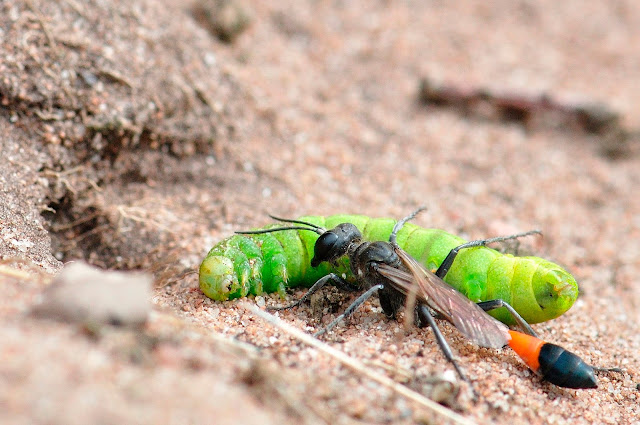I'll just let the series of photographs tell the story. One unlucky caterpillar gets entombed alive on Budby Heath Nottinghamshire and one impressive and stunning solitary wasp, Ammophila sabulosa gets to work. Surely one of best insects the UK has to offer. If you click on an image you can see them in larger format. Hope you enjoy them, I certainly liked observing them.
1. The wasp. Ammophila sabulosa. If it has a common name I'm not sure what it is and to be honest I'm not too bothered, just googled it, apparently known as the "red banded sand wasp". not very descriptive particularly when there are other wasps of similar appearance living in sandy environments. Ammophila has to make a good job of entombing the caterpillar as other Ammophila will come along and steal the caterpillar from the hole and reintern in a hole of its own construction with one of its own eggs.
2. Catch yourself a caterpillar and drag it several yards to a pre-prepared hole.
3. Get to your hole and admire your handiwork.
4. Admire your capture, Make sure it's paralysed.
5. Give it a cuddle. "It's actually positioning itself and the caterpillar"
6. Final positioning - Lining the caterpillar up with the hole.
7. Back yourself in, grab your prey and pull
8. Entombment begins.
9. Reminds me of the old wartime reels showing a U-boat going down.
10. Not quite sure how it gets itself back out past the caterpillar, however as soon as its put the caterpillar in it starts to backfill. Notice the sand aggregate in its mandibles.
11. A bit of back filling using its front legs to flick sand into the hole.
12. Final tamping down - and a little visit from the bee Colletes succinctus to take a look at a job well done.
.JPG)

.JPG)

.JPG)
.JPG)
.JPG)
.JPG)
.JPG)
.JPG)
.JPG)
.JPG)
Perfect Pictures. Congratulations.
ReplyDeleteThanks for the comment Ali. They were pretty active this year so it wasn't too difficult to find them if you know where to look.
Delete